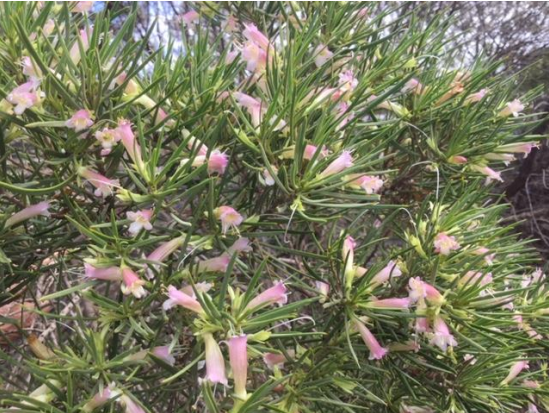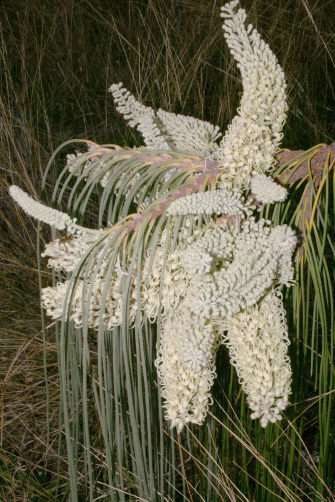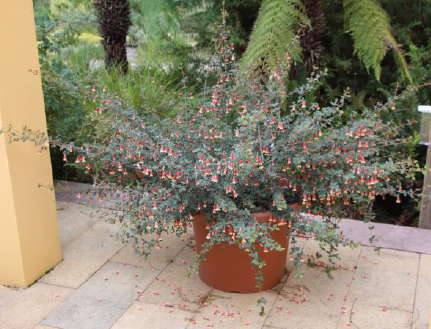Eremophila SG newsletter, no.142, April 2024

A spectacular feature plant in the garden, Eremophila oldfieldii, is highlighted in this issue. It is from WA and there are 3 subspecies currently recognised : ssp. oldfieldii, angustifolia and papula. A recent survey of growers shows that E. oldfieldii does best in full sun, and most soils are suitable, except for deep sand and waterlogged sites. There are hybrid forms with E. oppositifolia, of which the best known is “Piccaninny Dawn”, a rose-pink flowered variety which flowers pretty much all year.
Russell Wait reports on his experimental plantings of Eremophila seeds, mostly using naked seeds. Smoking, repeat smokings and using different mulches mixed into the potting mix, were two variables tested in spring and April plantings.
Future activities for the ESG include a possible revamp of the website. Group Leader Lyndal Thorburn will speak at the Biennial Conference in Melbourne, as well as being present for the Melton and Cranbourne botanic garden visits as these locations have a range of eremophilas. There may be a day event organised for group members in addition to the conference activities.
Study Group contact: lthorburn@viria.com
Acacia SG newsletter, no. 156, March 2024
Examples of small wattles are mentioned in the newsletter. These include Acacia applanata (grass-leaved wattle) from SW WA, which is a compact plant ideal for rockeries, and also another SW WA species which may be A. drewiana ssp minor. Of plants developed in cultivation, there is a dwarf A. cognata named “Bronze Cascade”, as well as an A. floribunda x cognata mini compact and other low and mounding forms.
Peter Goldup, a plant breeder from Mt Evelyn, Vic., notes that the economic climate at the moment is affecting nursery sales, such that nurseries are sticking to established varieties and reluctant to embark on new ones.
32 acacia species from the Tanami Desert (NT/WA) were identified on a recent trip by Geoff and Jannie Lay, and these are illustrated and described in the newsletter.
Study Group contact: acaciastudygroup@gmail.com
Hakea SG newsletter, no.84, February 2024

This issue focuses on Hakeas from northern areas of Australia. Even those from tropical/subtropical climates may be able to be grown in colder areas with lots of protection. Some species from the Barkly Tableland, NT have corky fissured bark to protect against fire damage. Hakea chordophylla, lorea, macrocarpa and arborescens are described. A weeping form of H. lorea grown at Burrendong Arboretum, Wellington, NSW is noteworthy (see photo).
Hakea persiehana, pedunculata, and plurinervia are North Queensland species. The latter species seems tolerant of conditions and worth trying by more members.
Study group contact is hakeaholic@gmail.com
Grevillea SG newsletter, no.127, February 2024
Peter Olde discusses the distribution and status of Grevillea calliantha from WA. Several visits over the years have tracked and observed the plant at a number of locations. Seed has been collected and plants re-established. Seed banking is working for this most threatened species. G. calliantha is very beautiful and can be recommended as a garden plant.
Lots of news this issue about Grampians grevilleas. Grevillea microstegia, the Mount Cassell grevillea is one of Victoria’s rarest plant species. In a Royal Botanic Garden Victoria program, a wide range of genetic material will be collected and conserved for this and a couple of other rare plant species.
Cranbourne Botanic Garden has a grant to research G. gariwerdensis and G. micrantha, both rare and extremely localized plants in the Grampians.
The WAMA Botanic Gardens at Halls Gap, Vic., are progressing well. It was initially planted out in July 2022, and a further plantout is planned for autumn. All the 7 or so Grampians endemic grevilleas are under cultivation, including many distinct forms. The beautiful yellow-flowered G. dimorpha var. angustifolia, now extinct in the wild, has established well, and contrasts with the normal red-flowered form.
Study group contact is Christine Guthrie at grevilleanews@gmail.com
Australian Plants for Containers SG newsletter, no. 43, February 2024

The newsletter provides photographs of members’ successes with their container gardening. Ian Cox of Kenthurst grows Blandfordia (Christmas Bells) in pots and finds a sheltered place with morning sun is ideal. Ferns do well in large pots. Ferns around the house give a sense of peace and tranquillity, and on a hot day you feel a bit cooler when you see them.
Ben Walcott recalls the selection of Correa “Canberra Bells” [pictured] as the official Canberra Centenary plant, trumping a yellow rose which had been the original idea. The Correa was selected from 20 candidates viewed by a selection panel at Bywong Nursery.
Member Maureen Mallard discusses the problem of tree roots invading pots, which she addresses by raising the pots on cunningly concealed bricks or tiles.
Study Group contact: roswalcott5@gmail.com ; benwalcott5@gmail.com
Fern SG newsletter, no.156, January 2024
A fabulous five-day trip to the Blue Mountains was enjoyed by the SE Queensland group in November. Leura Cascades, Mt Wilson, Wentworth Falls and Minamurra Falls were on the itinerary. A visit to Verdigris Fern Nursery completed the trip, with the quantity and variety of ferns on view providing a “visual assault”.
Dr Kevin Mills’ new book “South Coast Ferns : a complete guide to the ferns and fern allies of the NSW South Coast” (2023) is reviewed. It’s available from envirobook.com.au
Contact details: ANPSAferns@bigpond.com
Goodeniaceae SG newsletter, no.23, December 2023
Group leader Royce Raleigh’s garden at Wartook, Vic. has had a chequered time with waterlogging, dieback and frost damage; however his large Dampieras have generally flowered extremely well. He has 11 forms of Lechenaultia, including colour forms from the extensive range to be found in WA, eg along Greens Road north of Esperance.Rodger Elliot reports on a climbing form of Goodenia ovata. A collecting trip in the Little Sandy Desert, WA, by Graham and Maree Goods has resulted in the naming of two new species, Goodenia crescentiloba and G. aluta. Contact details: goodeniaceaestudygroup@gmail.com
Australian Food Plants newsletter, no.67, December 2023
The newsletter reports on the May 2023 Bushfoods Conference. Presentations were made by indigenous speakers, academics, wild foods producers and chefs, and experts on the medical uses of wild foods. Attila Kapitany has published a book entitled “Edible Australian Succulents”. A number of sample pages are provided. The aims include helping with identification and increasing the appreciation, understanding and general use of these plants.
The native guava, Rhodomyrtus psidioides, is close to being wiped out by the fungal disease myrtle rust. Affected plants keep pushing up new suckers only to be knocked back. More work need to be done to identify possible resistance traits.
Indigenous families in Far North Queensland have projects underway to develop an arid food industry using plants native to their homeland. In Arnhem Land, Maningrida Wild Foods is harvesting bush apples (a type of lilly pilly) for sale to restaurants. Native green plums (Buchanania obovata) have been found to have significant health benefits and commercial appeal. Contact details: australianfoodplants@gmail.com
